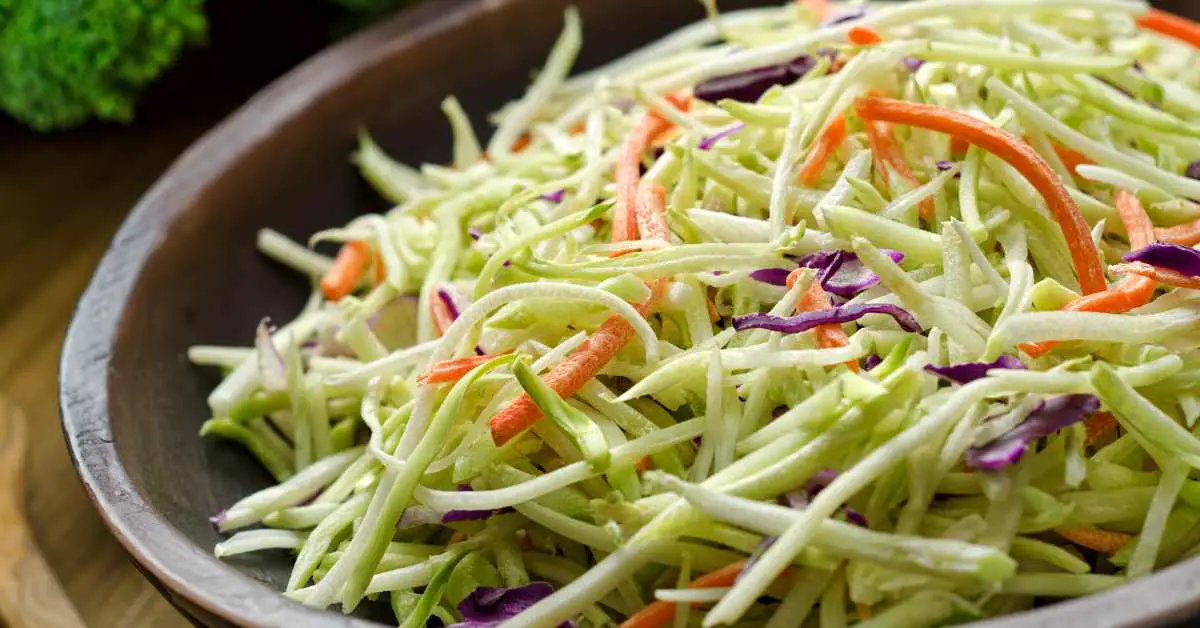Did you just have a delicious coleslaw at a family cookout and have a large container of coleslaw left? Or maybe you prepared homemade slaw for the first time, and you’re wondering, “How long does coleslaw last?” Well, you’re in the right place to find out. The answer really depends on a variety of factors, but mainly how it’s stored and the ingredients used.
When properly stored in an airtight container, homemade coleslaw can last 3-5 days in the fridge. However, store-bought coleslaw, thanks to the use of preservatives, has a slightly longer shelf life, typically around a week.
What Is In Coleslaw?
The main ingredient is cabbage, usually shredded or finely chopped. Dutch settlers brought the concept to America, calling it ‘koolsla,’ a Dutch word meaning cabbage salad. It is also made with other fresh vegetables like carrots and red cabbage.
The main feature of coleslaw, apart from the cabbage, is its dressing. Some people prefer a creamy, mayo-based dressing, while others enjoy a lighter, vinegar-based dressing. Dairy-based dressings are a classic choice, but soy sauce and vinegar dressing are also popular.
Store-bought dressings often contain stabilizers like xanthan gum to maintain the texture. Some coleslaw recipes even incorporate sour cream, lemon juice, or apple cider vinegar for added flavor.
How Long Can Coleslaw Sit Out?
Now, let’s say you had a barbecue, and you accidentally left some coleslaw out on the table. How long can it safely sit out at room temperature?
To answer this, we have to consider bacterial growth. When left out at room temperature for more than two hours, the risk of pathogenic bacteria, like E. coli, grows significantly. So, as a rule of thumb, don’t let your coleslaw sit out for longer than two hours, especially in summer.
At room temperature, the ingredients in coleslaw can quickly go bad, especially if it’s a mayo-based coleslaw, as these types of dressings provide a perfect environment for bacteria. If it’s been out longer, it’s best to play it safe and throw it away to avoid food poisoning.
How Long Does Coleslaw Last In Fridge?
Cold temperatures slow down bacterial growth, allowing your coleslaw can last longer. Stick with 3-5 days as a general rule and use an airtight container.
Tips For Making Homemade Coleslaw Last Longer
Separate Your Salad and Dressing
One of the best tips to extend the coleslaw’s shelf life is to store the salad and the dressing in separate containers. This prevents the cabbage from soaking up too much dressing and becoming watery over time.
Use Vinegar or Lemon Juice
Using vinegar or lemon juice in your dressing can help to naturally preserve your coleslaw, as the acidity inhibits bacterial growth.
Choose Fresh Vegetables
The fresher your ingredients, the longer your coleslaw will last. Be sure to check your cabbage and other vegetables for dark spots or signs of spoilage before adding them to your coleslaw mix.
Store Properly
Always use a clean airtight container for storage. The less air that can get in, the less likely bacterial growth will occur. Aluminum foil or plastic wrap alone is not enough – always use a container!
Keep it Cold
The coleslaw should be stored in the coldest part of your refrigerator. Higher temperatures can accelerate bacterial growth, reducing your coleslaw’s shelf life.
How Long Does Store-Bought Coleslaw Last In The Fridge?
Store-bought slaw, whether it’s KFC coleslaw or a generic brand from food stores, usually last longer than homemade coleslaw because it contains preservatives. Unopened, it can last up to two weeks past the printed date on the packaging if properly stored in the fridge. However, once opened, it’s best to eat it within 3-5 days.
The coleslaw type also matters. For instance, vinegar coleslaw often lasts longer than mayonnaise-based coleslaw because vinegar is a natural preservative. However, any type of coleslaw should be discarded if you notice any visible signs of spoilage.
Can You Freeze Coleslaw?
You might wonder if freezing is the best method to extend the life of your coleslaw. Well, it depends. If your coleslaw uses a vinegar-based dressing, it can be frozen successfully in a freezer-safe container or a freezer bag. The vinegar helps maintain the coleslaw’s texture and taste even after defrosting.
However, if your coleslaw recipe uses a creamy, mayonnaise, or sour cream-based dressing, freezing isn’t your best bet. These dressings tend to separate and become watery when defrosted, leading to a disappointing, watery coleslaw.
How To Defrost Coleslaw
For vinegar-based coleslaw, here’s the easiest way to defrost it: Simply move the frozen coleslaw to the refrigerator and let it thaw overnight. It’s not a good idea to rush the process by leaving it at room temperature or using a microwave, as this could promote bacterial growth.
Once your coleslaw is defrosted, give it a good stir to recombine any separated dressing. If the coleslaw seems too dry, you may add a bit of vinegar or dressing to restore its original consistency.
How To Tell If Your Coleslaw Has Gone Bad
Detecting spoiled coleslaw isn’t always easy to see. Clear signs include a sour or off smell and a slimy texture. If the coleslaw changes color, develops dark spots or grows mold, it’s definitely time to toss it.
Sometimes, signs of spoilage are not visible, especially in the early stages. If your coleslaw has exceeded the typical shelf life, even if it looks and smells okay, it’s best to err on the side of caution and discard it. Remember, when in doubt, throw it out!
What Happens If You Eat Coleslaw That Has Gone Bad?
Eating spoiled coleslaw is never a good idea. If it has gone bad, consuming it can lead to food poisoning, which can cause unpleasant symptoms such as stomach pain, nausea, vomiting, diarrhea, and fever. This is due to the growth of pathogenic bacteria or other microbes in spoiled food.
While these symptoms are usually not severe in healthy adults and tend to pass in a few days. They can be severe or even life-threatening for people with compromised immune systems, the elderly, and young children. So it’s best to avoid eating coleslaw that has gone bad.
Which Lasts Longer: Macaroni Salad Vs Coleslaw?
Macaroni Salad
Macaroni salad is often made with cooked elbow macaroni, various vegetables, and mayonnaise or vinegar-based dressing. It can typically last for about 3-5 days in the refrigerator. Factors such as the freshness of ingredients and storage conditions affect how long it keeps. Like coleslaw, macaroni salad should be stored in an airtight container and kept in the coldest part of the fridge. However, its shelf life could be shorter if it includes ingredients like hard-boiled eggs or cooked meats, which can spoil more quickly.
Coleslaw
Homemade coleslaw lasts around 3-5 days in the fridge, while store-bought coleslaw can stretch up to a week or slightly longer due to added preservatives. Vinegar-based slaw tends to last a little longer compared to mayo-based ones because vinegar acts as a natural preservative.
Overall, store-bought varieties generally outlast macaroni salad due to the use of preservatives.
Conclusion
When it comes to the question, “How long does coleslaw last?”, there are no simple answers. From homemade to store-bought, from vinegar-based to creamy, the lifespan of coleslaw can vary to a large extent. On average, homemade coleslaw can last 3-5 days in the fridge, while store-bought can stretch up to a week or more.
When storing coleslaw, always use a clean airtight container, separate the salad from the dressing, and always kept it in the coldest part of the refrigerator.
Coleslaw is one of the best side dishes, whether it’s a summer barbecue or a comforting winter meal. Enjoy it to the fullest, and keep the safety tips in mind!

Claudia Faucher is a fitness trainer and lifestyle blogger, who recently started to pursue her other passions… Southern cooking and creating recipes.







